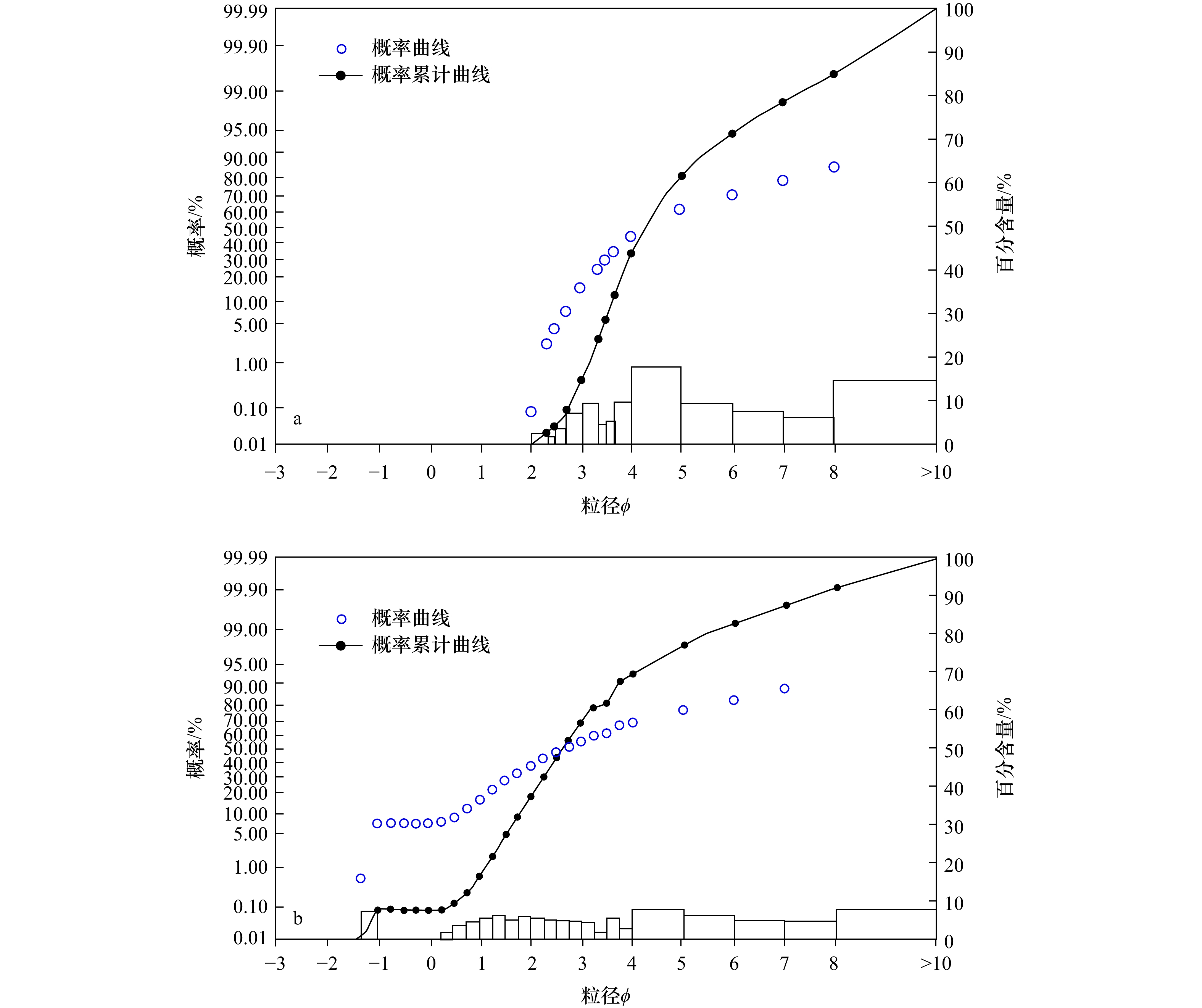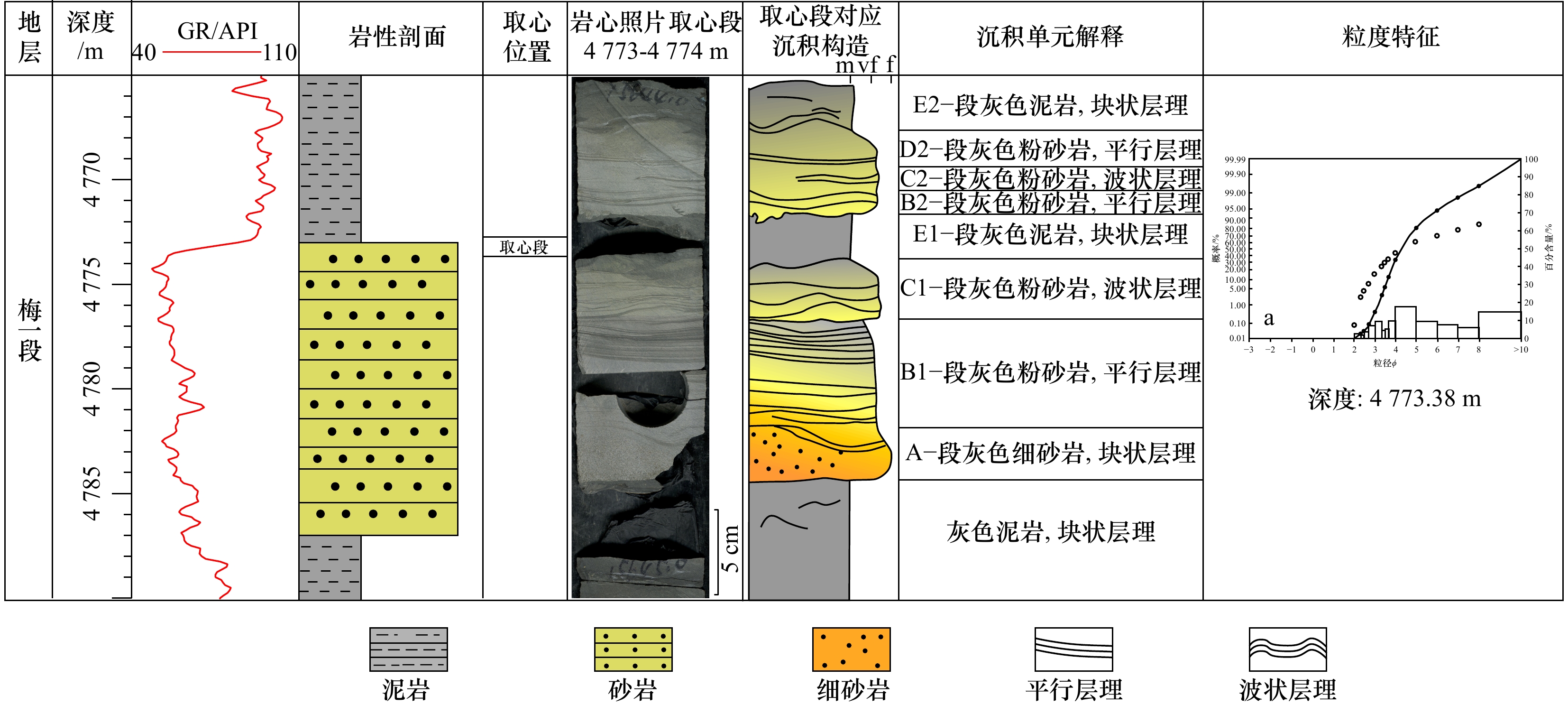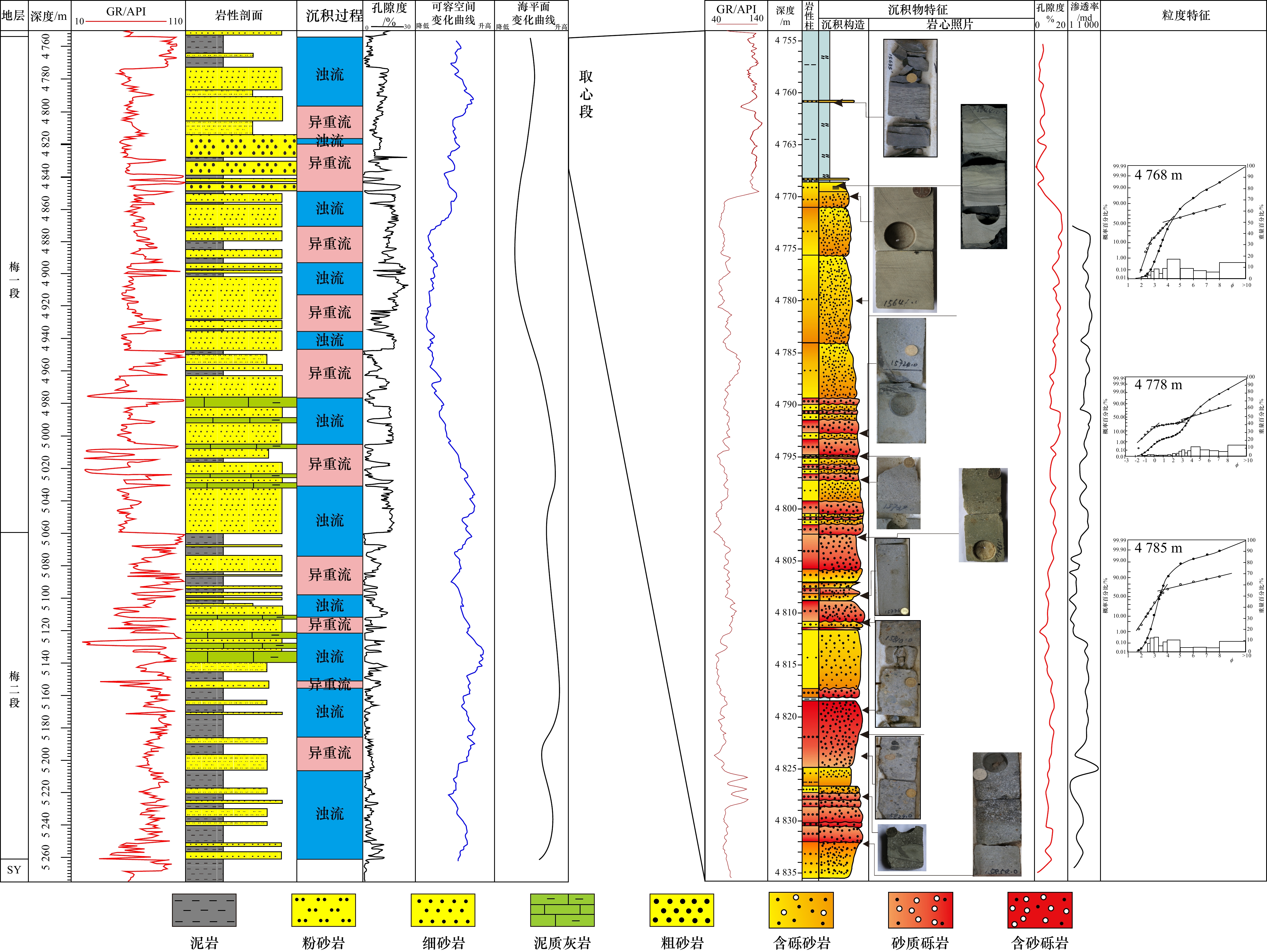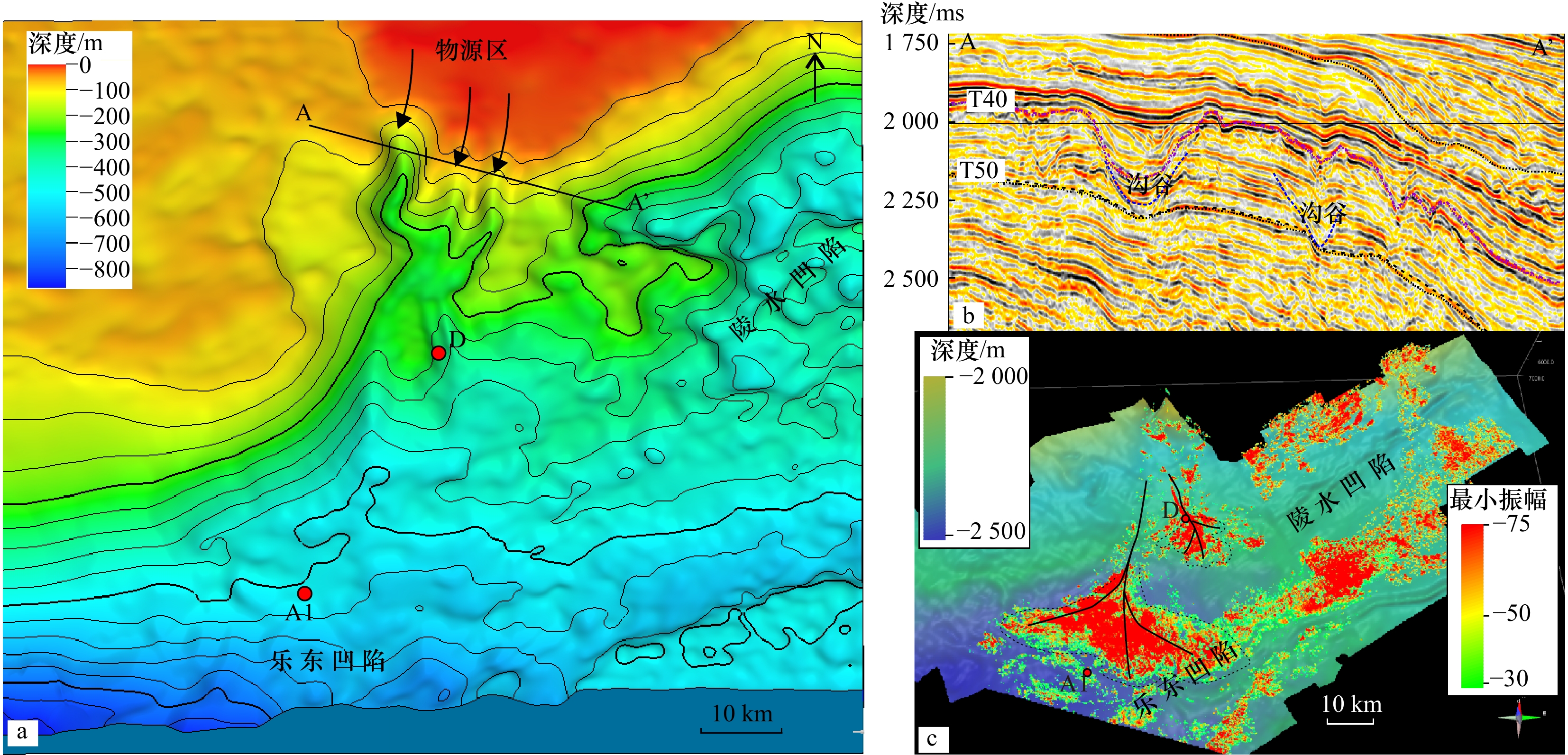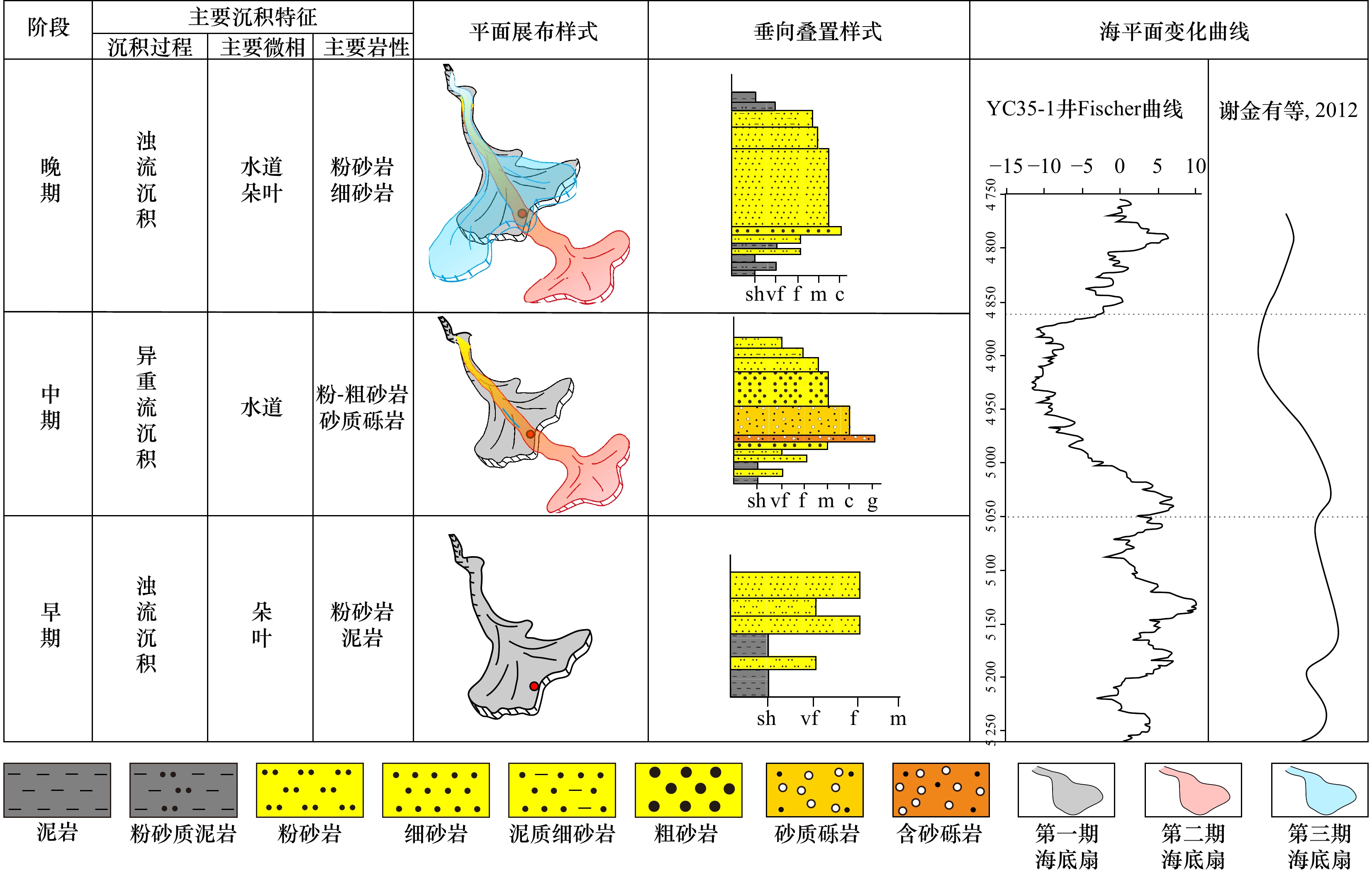Hyperpycnal flow found in submarine fan of the Meishan Formation in Ledong Sag in Qiongdongnan Basin:Evidence from the drilling cores
-
摘要: 琼东南盆地乐东凹陷梅山组海底扇天然气勘探潜力大。大多数学者认为梅山组海底扇为浊流成因,但钻井岩心揭示,砂砾岩中发育粒径高达5 cm的砾石,砂砾岩段磨圆度好,分选性差,海底扇的浊流成因无法解释此类砂砾岩成因,同时,经典的海底扇模式对砂体分布预测存在局限。基于岩心、薄片观察和粒度分析,对研究区海底扇岩石学特征和沉积构造开展系统研究,提出研究区海底扇为浊流和异重流交互沉积成因,区分了浊积岩与异重岩垂向叠置序列;结合古地貌特征,建立起梅山组海底扇成因演化模式。结果表明,研究区梅山组异重岩成分成熟度低,以长石质岩屑砂岩为主,岩石分选极差、磨圆次棱角−圆状,为中−高结构成熟度;块状砂质砾岩中,砾石定向排列、逆正粒序层理、平行层理、炭屑与生物化石碎片等构造是异重流沉积的典型特征;研究区海底扇发育多期浊积岩与异重岩叠置序列,梅山组早期以浊流沉积朵叶为主,中期以异重流沉积水道为主,晚期以浊流沉积水道为主,预测研究区南部发育更有利的海底扇储集砂体。成果可以为琼东南盆地海底扇有利砂体分布预测提供依据,对油气田勘探开发目标选取具有指导意义。Abstract: Submarine fans developed in the middle Miocene Meishan formation possess significant potential for natural gas exploration. Most of scholars believed that these Miocene submarine fans were formed primarily by turbidity currents. However, drilling cores reveal the presence of pebbles with a particle size of up to 5 cm in the sandy conglomerates. These sandy conglomerates exhibit good roundness and poor sorting, indicating that the traditional turbidity formation mechanism cannot fully explain the origin of this type of sandy conglomerates. Furthermore, the classic submarine fan model has limitations in predicting the distribution of sand bodies. Through a comprehensive study involving core, thin section observation, and grain size analysis, we have conducted a systematic investigation of the petrological characteristics and sedimentary structures of submarine fan in the study area. Our findings suggest that submarine fans in the study area resulted from the interaction of turbidity and hyperpycnal flow deposits. We have identified distinct sequences of turbidites and hyperpycnalites within the submarine fan. Based on the paleogeomorphlogy of the study area, we have established a genetic evolution model for the submarine fan in Meishan Formation. This model reveals that the hyperpycnites dominated by feldspathic litharenite, exhibit low compositional maturity. Poor sorting and subangular-circular of the rocks indicate middle-to-high structural maturity. Typical features of hyperpycnal flow include orientated gravel within block sandy conglomerates, reverse-to-normal grain order bedding, parallel bedding, carbonaceous debris, and biological fossil fragments. Multi stage superimposed turbidite sequence and hyperpycnites sequence developed in submarine fan in the study area. The early Meishan period is primarily composed of turbidite submarine fan lobes, while the middle Meishan period is dominated by hyperpycnites submarine fan channels. The late Meishan period, on the other hand, is mainly composed of turbidite submarine fan channels. We predict that more favorable submarine fan sand bodies could be found in the southern part of the study area. The results can serve as a basis for predicting the distribution of favorable submarine fan reservoirs of the Qiongdongnan Basin, and they hold significance for selecting exploration and development targets for hydrocarbon exploration.
-
Key words:
- hyperpycnal flow /
- sedimentary sequence /
- submarine fan /
- Meishan formation /
- Qiongdongnan Basin
-
图 2 琼东南盆地乐东凹陷梅山组岩性与岩石类型三角图
a. 砂质砾岩,砾石粒径最高5 cm,4 822.55 m,A1井;b. 含砂砾岩,分选差,次棱角-次圆状,4 822.5 m,A1井;c. 岩石成分三角图
Fig. 2 Lithology and triangular diagram of rock types of the Meishan Formation in the Ledong sag in Qiongdongnan basin
a. Sandy conglomerate, displaying the maximum grain size of gravel is larger than 5 cm in the core interval of 4 822.55 m in the A1 well. b. Sand bearing conglomerate, displaying poor sorting with the shape of sub angular - sub circular in the core interval of 4 822.5 m in the A1 well. c. Triangular diagram of the rock composition of the study area.
图 4 琼东南盆地乐东凹陷A1井梅山组典型沉积构造特征
a. 砂质砾岩侵蚀下部粉砂岩,4 828.03 m;b. 砂质砾岩侵蚀下伏粉砂质泥岩,4 824.68 m;c. 细砂岩侵蚀粉砂岩,粉砂岩侵蚀泥岩,4 825.29 m;d. 细砂岩、粉砂岩侵蚀下伏泥岩,可见砂岩底部槽模、平行层理、波状层理,4 768.29~4 768.60 m;e. 砂质砾岩,砾石长轴定向排列,最大砾石粒径大于5 cm,4 822.55 m;f. 粉砂岩侵蚀下伏粉砂质泥岩,粉砂岩中见丝带状泥砾呈叠瓦状排列,4 825.90 m;g. 砂质砾岩,见逆正粒序层理,碳酸盐岩碎屑,4 824.07~4 824.98 m;h. 砾质砂岩,见逆正粒序层理,内部可见侵蚀面,4 831.38~4 832.30 m;i. 砾质砂岩,细粒的砂岩中逆正粒序对厚度2~5 cm,4 823.16~4 824.07 m;j. 粉砂岩,可见炭屑呈丝带状排列,少量泥砾定向排列,4 825.59 m;k. 砂质砾岩,砂砾混杂堆积,可见植物碎片,4 830.47 m;l. 砂质砾岩,顶部见砾石长轴定向排列,发育碳酸盐岩砾石,4 819.5~4 820.17 m;m. 泥质粉砂岩,泥岩撕裂屑,包卷层理,4 824.37 m。Sh: 泥砾;T: 炭屑;P: 植物碎屑;Ca: 碳酸盐岩
Fig. 4 Sedimentary characteristics of the Meishan Formation in A1 well in the Ledong sag in Qiongdongnan basin
a. Sandy conglomerates erode the lower siltstone in the depth of 4 828.03 m; b. Sandy conglomerates erode the lower silty mudstone in the depth of 4 824.68 m; c. Fine sandstone erodes siltstone, and siltstone erodes mudstone in the depth of 4 825.29 m; d. Fine sandstone and siltstone erode the underlying mudstone, displaying grooves, parallel bedding, and wavy bedding at the bottom of the sandstone in the depth interval of 4 768.29~4 768.60 m. e. Sandy conglomerates, displaying oriented gravels with a maximum grain size of 5 cm gravel in the depth of 4 825.90 m; f. Siltstone erodes the lower silty mudstone, displaying filamentous gravel arranged in a layered tile pattern in the siltstone in the depth of 4 825.90 m; g. Sandy conglomerates, displaying inverse and normal grading with carbonates fragments in the depth interval of 4 824.07~4 824.98 m; h. Gravel sandstone, displaying inverse and normal grading and erosion surfaces inside in the depth interval of 4 831.38~4 832.30 m. i. Gravel sandstone, displaying fine-grained sandstone with a inverse and normal grading, with a thickness of 2-5 cm in the depth interval of 4 823.16~4 824.07 m; j. Siltstone, displaying carbon debris arranged in a ribbon like pattern, with a small mount of oriented rip-up clasts in the depth of 4 825.59 m; k. Sandy conglomerates, mixed with sandstone and conglomerates, see plant fragments in the depth of 4 830.47 m. l. Sandy conglomerates, displaying oriented gravels at the top and carbonate gravels in the depth interval of 4 819.5~4 820.17 m; m. Muddy siltstone, displaying rip-up clasts and convolute bedding in the depth of 4 824.37 m. Sh: rip-up clasts;T: carbon debris;P: plant debris;Ca: carbonates
图 8 琼东南盆地梅山组古地貌与地震属性特征
a. 琼东南盆地乐东凹陷梅山组沉积期古地貌; b. 物源区地震剖面特征(剖面位置见图a); c. 梅山组海底扇最小振幅属性与梅山组底界深度构造叠合图(据文献[16]修改)
Fig. 8 Characteristics of paleogeomorphology and seismic attribute of Meishan Formation in the Qiongdongnan basin
a. Paleogeomorphology of Meishan formation in the Ledong Sag in Qiongdongnan basin; b. Seismic profile of provenance, see the location in Fig. 8 a; c. The minimum amplitude of the submarine fan and the depth structure of the bottom of Meishan formation (modified after reference[16])
表 1 琼东南盆地乐东凹陷A1井梅山组碎屑岩沉积结构与成分成熟度
Tab. 1 Sedimentary structure and compositional maturity of A1 well clastic rock in Meishan Formation in the Ledong sag in Qiongdongnan basin
岩性 样品数 分选性 单晶石英(Q)百分含量/%
(低~高/平均)长石(F)百分含量/%
(低~高/平均)岩屑(R)百分含量/%
(低~高/平均)泥质杂基百分含量/%
(低~高/平均)结构与成分
成熟度评判砾岩 27 差 3−52/21.1 0−20.5/9.4 24−81.5/54.7 0−7/1.6 低结构成熟
极低成分成熟含砂砾岩 19 差 31−55.5/40.5 7−19/12.7 15.5−42/28 0−10/1.9 中−低结构成熟
低成分成熟粗砂岩 9 差 20−32.5/25.4 11−19/14.7 32−52/43.3 0−2/0.7 中结构成熟
极低成分成熟细−中砂岩 10 中 36−63/53.3 7−13/10.1 10.5−40/17.7 0−5/0.8 高结构成熟
中成分成熟粉砂岩 5 中 51.5−56/53.8 8−12/10 14.5−15.5/15 0−0/0 高结构成熟
中成分成熟 -
[1] Middleton G V, Hampton M A. Sediment gravity flows: mechanics of flow and deposition[M]//Middleton G V, Bouma A H. Turbidites and Deep Water Sedimentation: Short Course Lecture Notes, Part I. California: Los Angeles, 1973: 1−38. [2] Stow D A V, Mayall M. Deep-water sedimentary systems: new models for the 21st century[J]. Marine and Petroleum Geology, 2000, 17(2): 125−135. doi: 10.1016/S0264-8172(99)00064-1 [3] Nardin T R, Hein F J, Gorsline D S, et al. A review of mass movement processes, sediment and acoustic characteristics, and contrasts in slope and base-of-slope systems versus canyon-fan-basin floor systems[M]//Doyle L J, Pilkey O H. Geology of Continental Slopes. Tulsa: Special Publications of SEPM, 1979: 61−73. [4] Shanmugam G. 50 years of the turbidite paradigm (1950s-1990s): deep-water processes and facies models-a critical perspective[J]. Marine and Petroleum Geology, 2000, 17(2): 285−342. doi: 10.1016/S0264-8172(99)00011-2 [5] 庞雄, 柳保军, 颜承志, 等. 关于南海北部深水重力流沉积问题的讨论[J]. 海洋学报, 2012, 34(3): 114−119.Pang Xiong, Liu Baojun, Yan Chengzhi, et al. Some reviews on deep-water gravity-flow deposition in the northern south China Sea[J]. Haiyang Xuebao, 2012, 34(3): 114−119. [6] 李相博, 卫平生, 刘化清, 等. 浅谈沉积物重力流分类与深水沉积模式[J]. 地质论评, 2013, 59(4): 607−614.Li Xiangbo, Wei Pingsheng, Liu Huaqing, et al. Discussion on the classification of sediment gravity flow and the deep-water sedimentary model[J]. Geological Review, 2013, 59(4): 607−614. [7] Walker R G. Deep-water sandstone facies and ancient submarine fans: models for exploration for stratigraphic traps[J]. AAPG Bulletin, 1978, 62(6): 932−966. [8] Zavala C, 潘树新. 异重流成因和异重岩沉积特征[J]. 岩性油气藏, 2018, 30(1): 1−18.Zavala C, Pan Shuxin. Hyperpycnal flows and hyperpycnites: origin and distinctive characteristics[J]. Lithologic Reservoirs, 2018, 30(1): 1−18. [9] Muler T, Syvitski J P M, Migeon S, et al. Marine hyperpycnal flows: Initiation, behavior and related deposits. A review[J]. Marine and Petroleum Geology, 2003, 20(6/8): 861−882. [10] Mulder T, Syvitski J P M. Turbidity currents generated at river mouths during exceptional discharges to the world oceans[J]. The Journal of Geology, 1995, 103(3): 285−299. doi: 10.1086/629747 [11] Petter A L, Steel R J. Hyperpycnal flow variability and slope organization on an Eocene shelf margin, Central Basin, Spitsbergen[J]. AAPG Bulletin, 2006, 90(10): 1451−1472. doi: 10.1306/04240605144 [12] 潘树新, 刘化清, Zavala C, 等. 大型坳陷湖盆异重流成因的水道-湖底扇系统-以松辽盆地白垩系嫩江组一段为例[J]. 石油勘探与开发, 2017, 44(6): 860−870.Pan Shuxin, Liu Huaqing, Zavala C, et al. Sublacustrine hyperpycnal channel-fan system in a large depression basin: a case study of Nen 1 Member, Cretaceous Nenjiang Formation in the Songliao Basin, NE China[J]. Petroleum Exploration and Development, 2017, 44(6): 860−870. [13] 庞雄, 彭大钧, 陈长民, 等. 三级“源-渠-汇”耦合研究珠江深水扇系统[J]. 地质学报, 2007, 81(6): 857−864.Pang Xiong, Peng Dajun, Chen Changmin, et al. Three hierarchies “source-conduit-sink” coupling analysis of the Pearl River Deep-water fan system[J]. Acta Geologica Sinica, 2007, 81(6): 857−864. [14] 谢玉洪. 南海北部自营深水天然气勘探重大突破及其启示[J]. 天然气工业, 2014, 34(10): 1−8.Xie Yuhong. A major breakthrough in deepwater natural gas exploration in a self-run oil/gas field in the northern South China Sea and its enlightenment[J]. Natural Gas Industry, 2014, 34(10): 1−8. [15] 王振峰, 裴健翔, 郝德峰, 等. 莺-琼盆地中新统大型重力流储集体发育条件、沉积特征及天然气勘探有利方向[J]. 中国海上油气, 2015, 27(4): 13−21.Wang Zhenfeng, Pei Jianxiang, Hao Defeng, et al. Development conditions, sedimentary characteristics of Miocene large gravity flow reservoirs and the favorable gas exploration directions in Ying-Qiong basin[J]. China Offshore Oil and Gas, 2015, 27(4): 13−21. [16] 罗泉源, 焦祥燕, 刘昆, 等. 乐东-陵水凹陷梅山组海底扇识别及沉积模式[J]. 海洋地质与第四纪地质, 2020, 40(2): 90−99.Luo Quanyuan, Jiao Xiangyan, Liu Kun, et al. Identification of submarine fan in the Meishan Formation of the Ledong-Lingshui Sag in the Qiongdongnan Basin and its depositional model[J]. Marine Geology & Quaternary Geology, 2020, 40(2): 90−99. [17] 熊波, 苏龙, 张功成, 等. 琼东南盆地深水区崖城组煤系烃源岩定量评价[J]. 天然气地球科学, 2014, 25(4): 542−550.Xiong Bo, Su Long, Zhang Gongcheng, et al. Quantitative evaluation for coal-bearing source rocks of Yacheng Formation in the deepwater area of the Qiongdongnan Basin[J]. Natural Gas Geoscience, 2014, 25(4): 542−550. [18] 范彩伟, 李绪深, 刘昆, 等. 琼东南盆地乐东、陵水凹陷中新统岩性地层圈闭成藏条件[J]. 中国海上油气, 2016, 28(2): 53−59.Fan Caiwei, Li Xushen, Liu Kun, et al. Hydrocarbon accumulation condition of Miocene litho-stratigraphic trap in Ledong & Lingshui sags, Qiongdongnan basin[J]. China Offshore Oil and Gas, 2016, 28(2): 53−59. [19] 王亚辉, 张道军, 陈杨, 等. 琼东南盆地陵水凹陷梅山组深水扇特征及控制因素[J]. 新疆石油地质, 2014, 35(6): 664−667.Wang Yahui, Zhang Daojun, Chen Yang, et al. Characteristics and controlling factors of Meishan deep-water fans in Lingshui Sag, Qiongdongnan Basin[J]. Xinjiang Petroleum Geology, 2014, 35(6): 664−667. [20] 曾小明, 潘燕, 于佳, 等. 陵水凹陷北坡低密度浊流海底扇沉积特征[J]. 科学技术与工程, 2015, 15(33): 48−53,78.Zeng Xiaoming, Pan Yan, Yu Jia, et al. Low-density turbidity submarine fan sedimentary characteristics in North Slope of Lingshui Sag[J]. Science Technology and Engineering, 2015, 15(33): 48−53,78. [21] 左倩媚, 张道军, 王亚辉, 等. 琼东南盆地深水区新近系海底扇沉积特征与资源潜力[J]. 海洋学报, 2016, 38(11): 105−116.Zuo Qianmei, Zhang Daojun, Wang Yahui, et al. Sedimentary characteristics and exploration potential of Neogene submarine fan in the Deepwater area of the Qiongdongnan Basin[J]. Haiyang Xuebao, 2016, 38(11): 105−116. [22] 何云龙, 解习农, 陆永潮, 等. 琼东南盆地深水块体流构成及其沉积特征[J]. 地球科学-中国地质大学学报, 2011, 36(5): 905−913.He Yunlong, Xie Xilong, Lu Yongchao, et al. Architecture and characteristics of mass transport deposits (MTDs) in Qiongdongnan Basin in Northern South China Sea[J]. Earth Science-Journal of China University of Geosciences, 2011, 36(5): 905−913. [23] 王力. 琼东南盆地深水区中新世早中期沉积特征分析[D]. 西安: 西北大学, 2013.Wang Li. Analysis of sedimentary characteristics during early-mid Miocene in deep-water area of Qiongdongnan Basin[D]. Xi’an: Northwest University, 2013. [24] 李安琪, 胡林, 王真真, 等. 琼东南盆地乐东凹陷梅山组海底扇沉积演化及油气地质意义[J]. 油气地质与采收率, 2021, 28(2): 76−84.Li Anqi, Hu Lin, Wang Zhenzhen, et al. Sedimentary evolution of Meishan Formation submarine fan in Ledong Sag, Qiongdongnan Basin and its significance in hydrocarbon exploration[J]. Petroleum Geology and Recovery Efficiency, 2021, 28(2): 76−84. [25] 张功成. 南海北部陆坡深水区构造演化及其特征[J]. 石油学报, 2010, 31(4): 528−533, 541.Zhang Gongcheng. Tectonic evolution of deepwater area of northern continental margin in South China Sea[J]. Acta Petrolei Sinica, 2010, 31(4): 528−533, 541. [26] 李俊良, 左倩媚, 解习农, 等. 琼东南盆地深水区新近系沉积特征与有利储盖组合[J]. 海洋地质与第四纪地质, 2011, 31(6): 109−116.Li Junliang, Zuo Qianmei, Xie Xinong, et al. Neogene depositional features and favorable reservoir-cap combinations in the deepwater of Qiongdongnan Basin, Northern South China Sea[J]. Marine Geology & Quaternary Geology, 2011, 31(6): 109−116. [27] 雷闯. 琼东南盆地深水区油气成藏机制研究[D]. 武汉: 中国地质大学, 2011.Lei Chuang. Study on hydrocarbon accumulation mechanism in deepwater areas of Qiongdongnan Basin[D]. Wuhan: China University of Geosciences, 2011. [28] 姚哲, 朱继田, 左倩媚, 等. 琼东南盆地深水区重力流沉积体系及油气勘探前景[J]. 天然气工业, 2015, 35(10): 21−30.Yao Zhe, Zhu Jitian, Zuo Qianmei, et al. Gravity flow sedimentary system and petroleum exploration prospect of deep water area in the Qiongdongnan Basin, South China Sea[J]. Natural Gas Industry, 2015, 35(10): 21−30. [29] 王元. 莺琼盆地烃源岩生源构成、生烃潜力及其控藏作用研究[D]. 北京: 中国矿业大学(北京), 2018.Wang Yuan. Source composition, hydrocarbon generation potential of source rocks and its control on hydrocarbon accumulation in Yingqiong Basin[D]. Beijing: China University of Mining & Technology (Beijing), 2018. [30] 尤丽, 刘才, 钟佳, 等. 琼东南盆地西区梅山组海底扇岩相-地球化学特征及源区意义[J]. 地球科学, 2017, 42(9): 1531−1540.You Li, Liu Cai, Zhong Jia, et al. Petrography-geochemistry and source significance of submarine fan from west area of Qiongdongnan Basin[J]. Earth Science, 2017, 42(9): 1531−1540. [31] 潘树新, 郑荣才, 卫平生, 等. 陆相湖盆块体搬运体的沉积特征、识别标志与形成机制[J]. 岩性油气藏, 2013, 25(2): 9−18, 25.Pan Shuxin, Zheng Rongcai, Wei Pingsheng, et al. Deposition characteristics, recognition mark and form mechanism of mass transport deposits in terrestrial lake Basin[J]. Lithologic Reservoirs, 2013, 25(2): 9−18, 25. [32] Mulder T, Chapron E. Flood deposits in continental and marine environments: character and significance[M]//Slatt R M, Zavala C. Sediment Transfer from Shelf to Deep Water—Revisiting the Delivery System. AAPG Studies in Geology, 2011: 1-30. [33] 梁定勇, 伊海生, 邱余波, 等. 松辽盆地东岭地区泉头组高频沉积旋回的叠加型式分析[J]. 沉积学报, 2014, 32(2): 198−204.Liang Dingyong, Yi Haisheng, Qiu Yubo, et al. Analysis of high-frequency sedimentary cycle superposition type in Quantou Formation in Dongling area of Songliao Basin[J]. Acta Sedimentologica Sinica, 2014, 32(2): 198−204. [34] Muniz M C, Bosence D W J. Pre-salt microbialites from the Campos Basin (offshore Brazil): image log facies, facies model and cyclicity in lacustrine carbonates[J]. Geological Society, London, Special Publications, 2015, 418(1): 221−242. doi: 10.1144/SP418.10 [35] 熊连桥, 李建平, 谢晓军, 等. 湖相碳酸盐岩沉积微相类型及沉积模式——以坎波斯盆地东部下白垩统湖相碳酸盐岩为例[J]. 沉积学报, 2021, 39(3): 767−780.Xiong Lianqiao, Li Jianping, Xie Xiaojun, et al. Sedimentary microfacies and depositional model of lake carbonates: a case study of lower cretaceous carbonates in the eastern Campos Basin[J]. Acta Sedimentologica Sinica, 2021, 39(3): 767−780. [36] 谢金有, 祝幼华, 李绪深, 等. 南海北部大陆架莺琼盆地新生代海平面变化[J]. 海相油气地质, 2012, 17(1): 49−58.Xie Jinyou, Zhu Youhua, Li Xushen, et al. The Cenozoic sea-level changes in Yinggehai-Qiongdongnan Basin, Northern South China Sea[J]. Marine Origin Petroleum Geology, 2012, 17(1): 49−58. [37] 李胜勇, 胡林, 杨希冰, 等. 琼东南盆地梅山组海底扇成因演化特征与勘探建议[J]. 海洋地质前沿, 2023, 39(1): 18−30.Li Shengyong, Hu Lin, Yang Xibing, et al. Genetic evolution and exploration strategy of submarine fan in the Meishan Formation, Qiongdongnan Basin[J]. Marine Geology Frontiers, 2023, 39(1): 18−30. [38] Stevenson C J, Peakall J. Effects of topography on lofting gravity flows: implications for the deposition of deep-water massive sands[J]. Marine and Petroleum Geology, 2010, 27(7): 1366−1378. doi: 10.1016/j.marpetgeo.2010.03.010 [39] 刘昆, 宋鹏, 胡雯燕, 等. 南海北部琼东南盆地烃源岩发育特征与气源综合分析[J]. 海洋地质与第四纪地质, 2022, 42(6): 173−184.Liu Kun, Song Peng, Hu Wenyan, et al. Developmental characteristics of source rock and gas source analysis in Qiongdongnan Basin, Northern South China Sea[J]. Marine Geology & Quaternary Geology, 2022, 42(6): 173−184. -




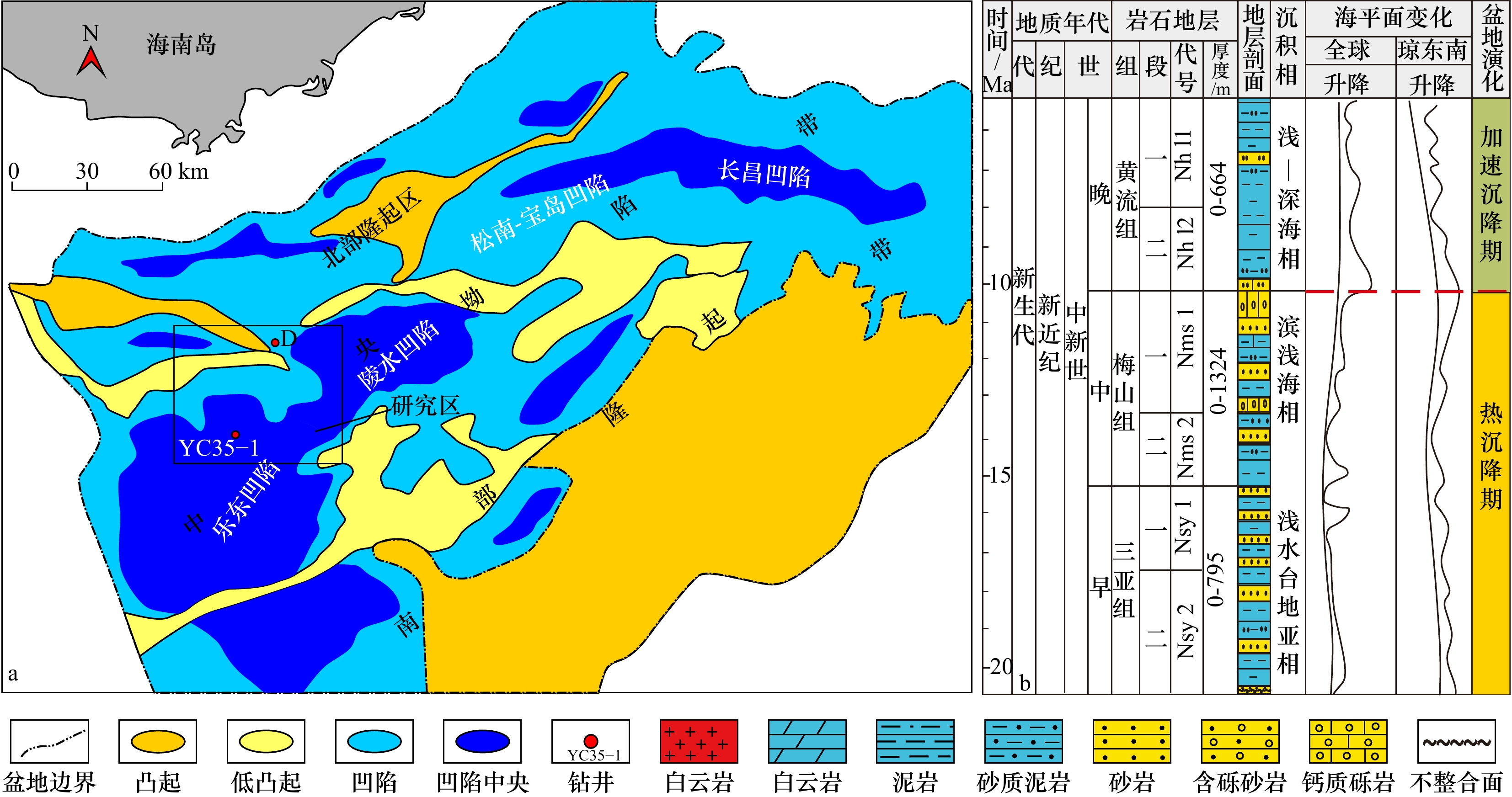
 下载:
下载:

